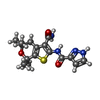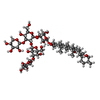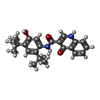+Search query
-Structure paper
| Title | Structural identification of a hotspot on CFTR for potentiation. |
|---|---|
| Journal, issue, pages | Science, Vol. 364, Issue 6446, Page 1184-1188, Year 2019 |
| Publish date | Jun 21, 2019 |
 Authors Authors | Fangyu Liu / Zhe Zhang / Anat Levit / Jesper Levring / Kouki K Touhara / Brian K Shoichet / Jue Chen /  |
| PubMed Abstract | Cystic fibrosis is a fatal disease caused by mutations in the cystic fibrosis transmembrane conductance regulator (CFTR). Two main categories of drugs are being developed: correctors that improve ...Cystic fibrosis is a fatal disease caused by mutations in the cystic fibrosis transmembrane conductance regulator (CFTR). Two main categories of drugs are being developed: correctors that improve folding of CFTR and potentiators that recover the function of CFTR. Here, we report two cryo-electron microscopy structures of human CFTR in complex with potentiators: one with the U.S. Food and Drug Administration (FDA)-approved drug ivacaftor at 3.3-angstrom resolution and the other with an investigational drug, GLPG1837, at 3.2-angstrom resolution. These two drugs, although chemically dissimilar, bind to the same site within the transmembrane region. Mutagenesis suggests that in both cases, hydrogen bonds provided by the protein are important for drug recognition. The molecular details of how ivacaftor and GLPG1837 interact with CFTR may facilitate structure-based optimization of therapeutic compounds. |
 External links External links |  Science / Science /  PubMed:31221859 / PubMed:31221859 /  PubMed Central PubMed Central |
| Methods | EM (single particle) |
| Resolution | 3.2 - 3.3 Å |
| Structure data | |
| Chemicals |  ChemComp-LJP:  ChemComp-MG:  ChemComp-ATP:  ChemComp-POV:  ChemComp-CLR:  ChemComp-AJP:  ChemComp-VX7: |
| Source |
|
 Keywords Keywords | HYDROLASE / ABC transporter / anion channel / cystic fibrosis / membrane protein / GLPG1837 / ivacaftor |
 Movie
Movie Controller
Controller Structure viewers
Structure viewers About Yorodumi Papers
About Yorodumi Papers







 homo sapiens (human)
homo sapiens (human)